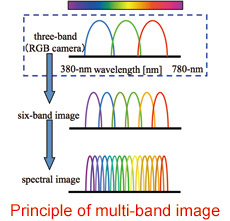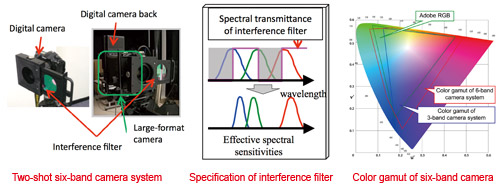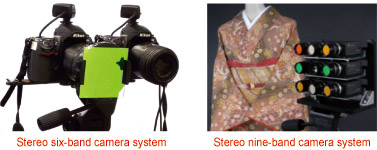High fidelity color reproduction and analysis
High fidelity color reproduction and analysis
Color and 3D shape reproduction using multi-band color images
When you take a picture using a digital camera, have you ever noticed color differences between the real object and displayed image? This is a very serious problem in the medical field and the field of archiving cultural heritage. We have been developing a technology for accurate color measurement and reproduction using multi-band images. Whereas ordinary imaging systems represent color as three-channel signals (red, green, and blue), our multi-band imaging system presents color using more than four-channel signals. Recently, we have developed two types of multi-band image capturing systems: a two-shot six-band camera system, consisting of a consumer-type digital camera and a custom interference filter for still picture, and one-shot stereo-type multi-band camera system for moving pictures.

(Multi-band image)
Visible-wavelength light reflected on an object’s surface is recorded as three-channel digital signal using a conventional three-band (red, green, and blue) digital camera. When the color of the reflected light is recorded with more than four-channel digital signals, we call the image a multi-band image. In addition to visible-wavelength light, multi-band imaging can be extended to ultra-violet and infra-red wavelengths, which enable us to improve the accuracy of color reproduction and color analysis.
How will it be Used in the Future?
When we use a three-band digital camera, the accuracy of color reproduction is not sufficient because of limitations on the recordable color range (vividness of color) and color resolution. In addition, the color appearance of an the object strongly depends on color of illumination. For precise color analysis using images captured under difference illumination, the effect of illumination should be removed. Spectral reflectance independent of illumination can be estimated from a multi-band image. Increasing the number of color channels enables us to improve the accuracy of spectral reflectance estimation. Color images of objects under various illuminations can then be simulated using estimated thespectral reflectance.
Two-shot six-band image capturing system
This system consists of a consumer-model digital camera and a custom interference filter. A normal RGB image is captured in the first step. Next, the interference filter is attached in front of the camera lens and a filtered color image is captured. The two captured three-band images are then combined into a six-band image. The features of this system are that an expensive custom imaging sensor is not required and ultra-high-definition (more than 100-M pixels) images can be obtained easily by combining a large-format camera and digital camera back. The average color difference of 24 color patch of Macbeth Color CheckerTM displayed on LCD monitor, ![]() is 1.19 when the six-band system is used (
is 1.19 when the six-band system is used (![]() is 3.12 when the three-band system is used). And we have also confirmed experimentally that this camera system has a wider color gamut than Adobe RGB. This system has been using in a demonstration experiment in the field of high-definition digital archiving of cultural heritage.
is 3.12 when the three-band system is used). And we have also confirmed experimentally that this camera system has a wider color gamut than Adobe RGB. This system has been using in a demonstration experiment in the field of high-definition digital archiving of cultural heritage.

One-shot stereo-type multi-band image capturing system
The two-shot six-band camera system cannot capture moving objects and moving pictures. For this purpose, we are developing a one-shot multi-band image capturing system by combining a multi-view stereo camera and various interference filters. This system can capture multi-band color information and 3D shape information at one time. In this system, captured stereo images should be converted into images virtually captured at a view-point. We are also developing a fast image conversion method.

